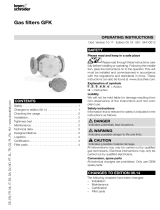
64 MHz, 32-Bit Floating Point Central Processing Unit
1 Mbyte Memory, State Logic
IC697CSE925
PLC CPUs
GFK-1167B
August 1997
4
62
64 MHz, 32-Bit Floating Point Central Processing Unit 1 Mbyte Memory, State Logic (IC697CSE925)
datasheet GFK-1167B
Features
Supports State Logic control programming
Supports floating point calculations
Single slot CPU.
12K inputs and outputs (any mix).
Up to 8K analog I/O.
0.4 microseconds per boolean function.
64 MHz, 80486DX2 microprocessor.
Supports IC660/IC661 and IC697 I/O products.
Programmed by AD641 and IC641 (MS-DOS ) software
products.
Provides 1 Mbyte of battery-backed memory in the same
slot.
Configurable data and program memory.
Battery-backed calendar clock.
Three position operation mode switch.
Password controlled access.
Remote programmer keyswitch memory protection
Four status LEDs.
Software configuration (No DIP switches or jumpers to
set).
Reference information inside front door.
In-system upgradable firmware.
Functions
The CSE 925 is a single slot programmable controller
CPU which provides State Logic control programming
and floating point calculations. The CSE 925 can be
programmed in State Logic, Relay Ladder Logic, and
C to perform real-time control of machines, processes,
and material handling systems.
The AD641 software products are used to program
the CSE 925 in State Logic; the IC641 (MS-DOS) soft-
ware products are used to program in Relay Ladder
Logic and C. The IC641 (MS-DOS) software is also
used to perform all configuration functions for the
CSE 925.
The CSE 925 communicates with I/O and smart op-
tion modules over the rack mounted backplane
(IC697CHS750, 782, 783, 790, 791) by way of the VME
C.1 Standard format.
PROGRAMMER
a45242
OK
RUN
ENABLED
MEM PROTECT
STATE LOGIC
CPU
Y
R
E
B
A
T
T
MODULE
IC697CSE925
LABEL
44A726758-148R01
SERIAL PORT
USE THIS MODULE
CSE 925
OFF
ON
TOP
REMOTE PROGRAMMER
MODULE OK
RUN
OUTPUTS
ENABLED
ON = OK, ENABLED,
FRONT
RUN WITH
OUTPUTS
ENABLED
RUN WITH
OUTPUTS
DISABLED
STOP
KEY POSITION
MODULE FUNCTION
64 MHz 32 BIT CENTRAL
PROCESSING UNIT WITH
BATTERY
CONNECTORS
INSTALL NEW
MEMORY PROTECT
MEMORY
REMOTE
ONLY
RS-485
COMPATIBLE
PROTECT
PROTECTED
FLOATING POINT MATH
COPROCESSOR, IN-SYSTE
M
UPGRADABLE FIRMWARE
BATTERY BEFORE
UNPLUGGING OLD
BATTERY. USE
IC697ACC701
IN SLOT 1 ONLY.
MS-DOS is a registered trademark of Microsoft Corporation.

64 MHz, 32-Bit Floating Point Central Processing Unit
1 Mbyte Memory, State Logic
GFK-1167B
PLC CPUs
2
August 1997
MEMORY
PROTECT
a45243
OPEN
REPLACEMENT
BATTERY
CONNECTOR
1 MBYTE
MEMORY BOARD
CSE 925
CURRENTLY
INSTALLED
BATTERY
CONNECTOR
MEMORY
PROTECT
KEY
SWITCH
Y
R
E
B
A
T
T
MODULE
IC697CSE925
LABEL
44A726758–148R01
SERIAL PORT
USE THIS MODULE
IN SLOT 1 ONLY
CSE 925
OFF
ON
TOP
REMOTE PROGRAMMER
MODULE OK
RUN
OUTPUTS
ENABLED
ON = OK, ENABLED,
PROTECTED
FRONT
RUN WITH
OUTPUTS
ENABLED
RUN WITH
OUTPUTS
DISABLED
STOP
KEY POSITION
MODULE FUNCTION
BATTERY
CONNECTORS
INSTALL NEW
BATTERY BEFORE
UNPLUGGING OLD
BATTERY. USE
IC697ACC701
MEMORY PROTECT
REMOTE
PROGRAMMER
ONLY
RS-485
COMPATIBLE
64 MHz 32 BIT CENTRAL
PROCESSING UNIT WITH
FLOATING POINT MATH
COPROCESSOR, IN-SYSTEM
UPGRADABLE FIRMWARE
Figure 1. CSE 925 - Location of Major Features
Supported option modules include IC697 LAN Interface
modules, Programmable Coprocessor, Alphanumeric
Display Coprocessor, Bus Controller for IC660/IC661 I/O
products, Communications modules, I/O Link Interface,
and all of the IC697 family of discrete and analog I/O
modules.
User Memory
Program and data memory for the CSE 925 is provided by
a memory board with 1 Mbyte of battery-backed CMOS
RAM. This memory board is an integral part of the CSE
925 module and does not need to be ordered separately.
Operation, Protection, and Module Status
Operation of this module can be controlled by the
three-position RUN/STOP switch or remotely by an
attached programmer, and AD641 or IC641 (MS-DOS)
software. Program and configuration data can be locked
through software passwords or manually by the memory
protect keyswitch. When the key is in the protected
position, program and configuration data cannot be
changed. The status of a CPU is indicated by the four
green LEDs on the front of the module.
The CSE 925 requires forced air cooling for proper
operation in ambient temperatures greater than 40 C
(104 F). A fan capable of 70 CFM (including filters) should
be located beneath slot 1 of the rack containing the CPU.
Fan assemblies (IC697ACC 721 and IC697ACC724) can be
ordered for direct mounting on the IC697 rack. Refer to
the applicable Programmable Controller Installation Manual
for detailed information.
Installation
It is the responsibility of the OEM, system integrator, or
end user to properly install the PLC equipment for safe
and reliable operation. Product manuals provide
detailed information about installation, startup, and
proper use of the PLC equipment. The installation
manual, shipped with your PLC programming software,
describes how to properly install the equipment. If the
PLC installation must comply with supported standards,
such as FCC or CE Directives, please refer to the
Installation Requirements for Conformance to Standards,
shipped with the PLC programming software, for
additional guidelines.
Installation should not be attempted without refer-
ring to the applicable Programmable Controller Installa-
tion Manual.
Connect the battery to either of the battery connec-
tors on the module (see Figure 1).
Put the toggle switch in the STOP position.
Put the keyswitch in the Memory Protection OFF
position.

3
64 MHz, 32-Bit Floating Point Central Processing Unit
1 Mbyte Memory, State Logic
GFK-1167B
PLC CPUs
August 1997
Make sure that rack power is off.
Install the CSE 925 module in slot 1 of rack 0 (see
Figure 2).
Turn on power.
The module should power up and the top LED should
blink. When the diagnostics have completed successfully,
the top LED stays on and the second and third LEDs are
off. The fourth LED is off if the keyswitch is in the OFF
position. The CPU is now ready to be programmed.
After the program has been verified the toggle switch may
be moved to the appropriate operation mode position.
The LEDs indicate the position of the toggle switch,
memory protection status, and the state of the program.
The IC641 (MS-DOS) software is also used to load the State
Logic operating system into the CSE 925 CPU module.
The operating system is provided on a floppy disk with
the CSE 925. The operating system is stored in flash
memory on the module. For information on loading the
operating system, see the State Logic Control System User’s
Manual.
IC66* I/O BUS (7500 FEET (2285 METERS) MAXIMUM)
B
R
M
a45301
IC66*
I/O BLOCK
PROGRAMMER
RACK 1
RACK 0
P
S
C
P
U
B
T
M
G
B
C
B
R
M
RACK 7
ONE
METER
TOTAL LENGTH OF ALL INTERCONNECTING
CABLES FROM BTM TO LAST BRM IS
50 FEET(15 METERS) MAXIMUM. ALL RACKS
MUST BE AT SAME GROUND POTENTIAL
(8 RACKS MAXIMUM).
NOTE
SERIAL
TERMINATOR PLUG (IC697ACC702)
P
C
M
FORCED AIR COOLING REQUIRED FOR
PROPER OPERATION. REFER TO TEXT.
*
*
RACK FAN ASSEMBLY IC697ACC721/724
AVAILABLE FOR DIRECT MOUNTING ON
RACK.
or
N
B
C
Figure 2. System Configuration, Serial Connection to
Programmer
Serial Port
The 15-pin D-connector provides the connection to an
RS-485 compatible serial port on the CPU as shown in
Figure 2.
The serial connection is made from the serial port on the
CPU to the serial port on the programming computer, or
other serial device, through the RS-422/RS-485 to
RS-232 Converter (IC690ACC900) or RS-232 to RS-422
Miniconverter (IC690ACC901). This connection can be
made with available cables or you may build cables to fit
the needs of your particular application. See reference
3 for more information on serial communications.
Configuration
The IC697 CPU and I/O system is configured with IC641
(MS-DOS) programming software. There are no DIP
switches or jumpers used to configure the system. The
CPU verifies the actual module and rack configuration
at power-up and periodically during operation. The
actual configuration must be the same as the
programmed configuration. Deviations are reported to
the CPU alarm processor function for configured fault
response. Consult Reference 1 for a description of
configuration functions.
Batteries
A lithium battery (IC697ACC701) is installed as shown
in Figure 1. This battery maintains program and data
memory when power is removed and operates the
calendar clock. Be sure to install the new battery before
removing the old battery. Specific indication of a low
battery state is detailed in Reference 2.
Removing a Module
The instructions below should be followed when
removing a module from its slot in a rack.
Grasp the board firmly at the top and bottom of
the board cover with your thumbs on the front of
the cover and your fingers on the plastic clips on
the back of the cover.
Squeeze the rack clips on the back of the cover
with your fingers to disengage the clip from the
rack rail and pull the board firmly to remove it
from the backplane connector.
Slide the board along the card guide and remove
it from the rack.

64 MHz, 32-Bit Floating Point Central Processing Unit
1 Mbyte Memory, State Logic
GFK-1167B
PLC CPUs
4
August 1997
Table 1. References
Reference Title
1 Programming Software User’s Manual
2 Programmable Controller Reference Manual
3 Programmable Controller Installation Manual
4 State Logic Control System User’s Manual
Table 2. Specifications for IC697CSE925
Battery
Shelf life 10 years at 20 C (68 F)
Memory retention 6 months nominal without applied power.
Current required from 5V bus 3.3 Amps nominal
Time of Day Clock accuracy " 3.5 seconds per day maximum
Elapsed Time Clock (internal timing) accuracy " .01% maximum
Serial Port
RS422/485 compatible Programmer Serial Attachment
VME System designed to support the VME standard C.1
Refer to GFK-0867B, or later for product standards and general specifications.
Table 3. Ordering Information
Description Catalog Number
Central Processing Unit - 64 MHz, 32-Bit,
Floating Point, 1 Mbyte Memory, State Logic
IC697CSE925
Lithium Battery IC697ACC701
Rack Fan Assembly, 120 VAC
Rack Fan Assembly, 240 VAC
IC697ACC721
IC697ACC724
Note: For Conformal Coat option, or Low Temperature Testing option please
consult the factory for price and availability.
-
 1
1
-
 2
2
-
 3
3
-
 4
4
Microsoft GFK-1167B User manual
- Type
- User manual
- This manual is also suitable for
Ask a question and I''ll find the answer in the document
Finding information in a document is now easier with AI
Other documents
-
Steren 14017 Owner's manual
-
 Kromschroder GFK Datasheet
Kromschroder GFK Datasheet
-
State Industries GFK-0827 User manual
-
GE GFK-0726B User manual
-
GE GFK-1004B User manual
-
GE Logiq 500 User manual
-
 Tekxon Technology Ventilation Hood AWG2021 User manual
Tekxon Technology Ventilation Hood AWG2021 User manual
-
 Kromschroder GFK Operating instructions
Kromschroder GFK Operating instructions
-
Motorola MJ15024-MOT Datasheet
-
Texas Instruments TNETX3270 User manual






